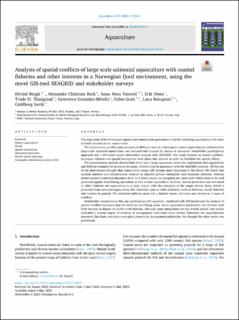| dc.contributor.author | Bergh, Øivind | |
| dc.contributor.author | Beck, Alexander Christian | |
| dc.contributor.author | Tassetti, Anna Nora | |
| dc.contributor.author | Olsen, Erik Joel Steinar | |
| dc.contributor.author | Thangstad, Trude Hauge | |
| dc.contributor.author | Gonzalez-Mirelis, Genoveva | |
| dc.contributor.author | Grati, Fabio | |
| dc.contributor.author | Bolognini, Luca | |
| dc.contributor.author | Søvik, Guldborg | |
| dc.date.accessioned | 2023-10-04T13:16:03Z | |
| dc.date.available | 2023-10-04T13:16:03Z | |
| dc.date.created | 2023-05-09T16:57:39Z | |
| dc.date.issued | 2023 | |
| dc.identifier.citation | Aquaculture. 2023, 574 . | |
| dc.identifier.issn | 0044-8486 | |
| dc.identifier.uri | https://hdl.handle.net/11250/3094184 | |
| dc.description.abstract | The expansion of the Norwegian aquaculture industry has generated a need for balancing aquaculture with other societal interests in the coastal zone. The interactions, conflicts and synergies of different uses of a Norwegian coastal region heavily influenced by large-scale salmonid aquaculture was analyzed and mapped by means of systematic stakeholder participatory approach and a GIS-based spatial interaction analysis tool, SEAGRID. Our study focused on spatial conflicts/synergies, whereas non-spatial interactions were taken into account in order to elucidate the spatial effects. The questionnaire analysis showed that there was a large agreement across the respondents that aquaculture and fisheries compete for access to sea areas, which is also in agreement with the SEAGRID analysis. All but one of the interviewees thought that conservation issues will become more important in the future. We found that societal interests and infrastructure obstruct or displace private enterprises and economic interests, whereas environmental protection measures do so to a lesser extent; an exception are coral reefs which seem to be well protected against both fishing operations as well as new aquaculture facilities. Nature protection was not found to affect fisheries nor aquaculture to a large extent, with the exception of the single salmon fjord, which is protected from salmonid aquaculture, but otherwise open to other activities, such as fisheries, tourist fisheries and tourism in general. The restricted military areas had a limited extent, and were not viewed as a cause of conflicts. Stakeholder consultations, like our participatory GIS approach, combined with GIS-based tools for analysis of spatial conflicts/synergies may be useful in identifying areas where aquaculture production can increase with little increase in degree of conflict with fisheries, although some interactions are not strictly spatial. Our results indicated a certain degree of mistrust of management authorities since neither fishermen nor aquaculturists perceived that their own sector was given priority by management authorities, but thought the other sector was prioritized. | |
| dc.description.abstract | Analysis of spatial conflicts of large scale salmonid aquaculture with coastal fisheries and other interests in a Norwegian fjord environment, using the novel GIS-tool SEAGRID and stakeholder surveys | |
| dc.language.iso | eng | |
| dc.title | Analysis of spatial conflicts of large scale salmonid aquaculture with coastal fisheries and other interests in a Norwegian fjord environment, using the novel GIS-tool SEAGRID and stakeholder surveys | |
| dc.title.alternative | Analysis of spatial conflicts of large scale salmonid aquaculture with coastal fisheries and other interests in a Norwegian fjord environment, using the novel GIS-tool SEAGRID and stakeholder surveys | |
| dc.type | Peer reviewed | |
| dc.type | Journal article | |
| dc.description.version | publishedVersion | |
| dc.source.pagenumber | 23 | |
| dc.source.volume | 574 | |
| dc.source.journal | Aquaculture | |
| dc.identifier.doi | 10.1016/j.aquaculture.2023.739643 | |
| dc.identifier.cristin | 2146586 | |
| dc.relation.project | Norges forskningsråd: 258831 | |
| dc.relation.project | EC/FP7/245178 | |
| dc.relation.project | Norges forskningsråd: 299554 | |
| cristin.ispublished | true | |
| cristin.fulltext | original | |
| cristin.qualitycode | 2 | |
